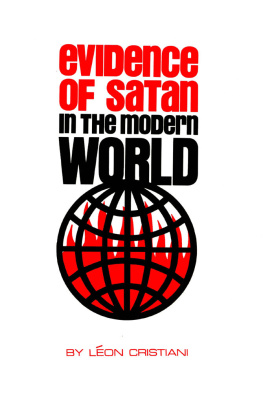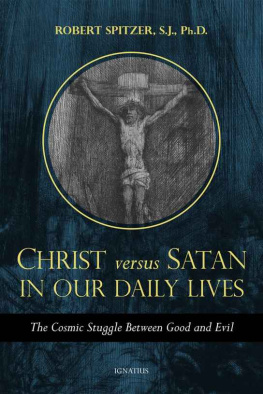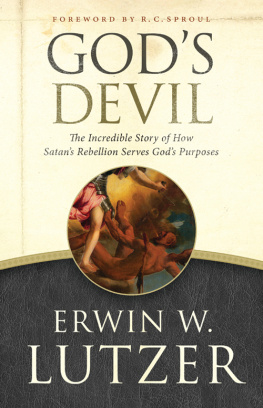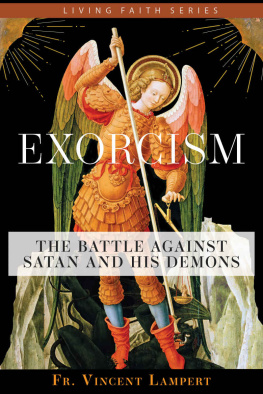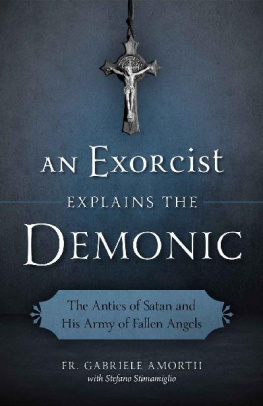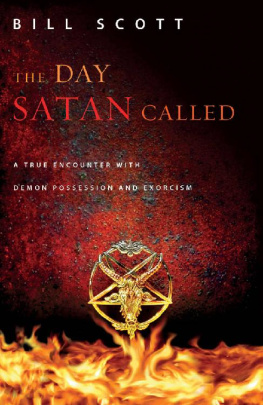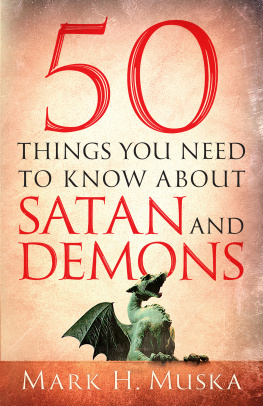Evidence of Satan
In the Modern World
Lon Cristiani
Nihil obstat
R. D. Dermitius Fogarty, D.D., L.C.L. R. D. Kilianus Lynch, D.D., D.C.L., O.Carm. CENSORES DEPUTATI
Imprimatur
Cyrillus
EPISCOPUS SOUTHWARCENSIS
Datum Southwarci die 5a Junii 1961
BARRIE & ROCKLIFF (Barrie Books Ltd.), 1961
This book was published in England under the title Satan in the Modern World French edition, Prsence de Satan dans le monde moderne , 1959 by Editions France-Empire, Paris
All rights reservedno part of this book may be reproduced in any form without permission in writing from the publisher, except by a reviewer who wishes to quote brief passages in connection with a review written for inclusion in magazine or newspaper.
Library of Congress catalog card number: 62-9278
TAN Books
Charlotte, NC
www.TANBooks.com
1974
CONTENTS
INTRODUCTION
WHEN we declare that a certain statement is, or is not, Gospel truth, we are trying to say that it is, or is not, strictly credible.
Christ, to Christians, is the final authority to which we submit in all confidence, faith and love. Even to unbelievers Christ is one of the most outstanding personalities in history. He is the personification of sincerity and truth, and is recorded as saying: 'Let your word be Yes for Yes, and No for No; whatever goes beyond this, comes of evil.'
We should therefore enquire what Jesus thought and said on the subject of Satan. Here the Gospel, as on all other points which concern man's spiritual life, is normative and definitive. Even if this should no longer be true for those who have lost their faith, it is nevertheless impossible to understand the mentality of previous centuries in France without reference to the Gospels. Those who had, or believed they had had, contact with the Devil, those who had endured his onslaughts, like the Cur d'Ars; those who were regarded as 'possessed' and subjected to a more or less effective exorcism, have all interpreted their state in the light of the Gospels and the traditions derived therefrom.
Let us therefore see what the Bible has to say of Satan, and how it records cases of possession and the expulsion of devils. In particular we should note whether Christ himself believed in the existence of Satan.
THE TEMPTATION IN THE WILDERNESS
The first event to attract our attention is Christ's temptation in the wilderness, recorded in three Gospels. They show Christ and Satan meeting face to face. We should note, however, that there was no witness to this formidable encounter. The three Evangelists derived their account from Jesus himself. He took care to inform his disciples of what had passed between the Devil and himself. He wished them to know what he had seen, what it had meant to look each other, as one says, in the eye, to listen to Satan's attempts to subjugate him, and make him deviate from his path. In a word, Christ had wished to be tempted. And he was. He revealed to his followers what this temptation had been. Satan had shown him all the kingdoms of the world, saying: 'I will give thee command over all these, and the glory that belongs to them; they have been made over to me, and I may give them to whomsoever I please; come then, all shall be thine, if thou wilt fall down before me and worship' (Luke IV, 6, 7).
The temptation therefore was no slight one, but on a world scale, on a scale Satan considered appropriate to his task.
Jesus, for his part, admitted Satan's predominance in all the kingdoms of the earth by thrice calling him 'prince of this world' (John XII, 31; XIV, 30; XVI, 11). Fr. Lagrange, speaking of these accounts of the temptation in the wilderness, compares them with the prologue of classical tragedy, in which the theme of the forthcoming drama is announced and, as it were, prefigured. The battle in the desert between Christ and the Devil is such a prologue. It tells us everything about Christ's mission, which was solely to overthrow the dominion of Satan. St. John was to say in his first Epistle: 'If the Son of God was revealed to us, it was so that he might undo what the Devil had done' (I John III, 8). We might therefore expect the Gospels to be full of the work of Christ against Satan, and of Satan against Christ, and they are indeed so, to an astonishing degree. It is impossible to understand the Gospels without the certainty of Satan's existence and of his activity amongst us.
SOME EXAMPLES
It would not be possible to list every instance in which devils are mentioned in the New Testament, and we shall quote only some important examples.
Jesus began to preach in Galilee, and St. Mark writes that he 'cast out many devils' (Mark I, 34). Before the Sermon on the Mount the crowds gathered round him and St. Luke tells us why: 'to be healed of their diseases; and those who were troubled by unclean spirits were also cured' (Luke VI, 18). 'For,' says St. Matthew, 'they brought to him all those who were in affliction, distressed with pain and sickness of every sort, the possessed, the lunatics, the palsied; and he healed them' (Matthew IV, 24).
In the case of Mary Magdalene, it is made clear that Jesus had cast out from her 'seven devils' (Luke VIII, 2). When Jesus sends his apostles to preach in Galilee, he gives them power to cast out devils. When they return, he greets them joyfully: 'I watched, while Satan was cast down like a lightning-flash from Heaven...' (Luke X, 18).
When Christ healed the woman 'who for eighteen years had suffered under some influence that disabled her' and the ruler of the synagogue waxed indignant because it was the Sabbath, Jesus replied: 'What, you hypocrites, is there any one of you that will not untie his ox or his ass from the stall and take them down to water, when it is the Sabbath? And here is this daughter of Abraham, whom Satan had kept bound these eighteen years past; was it wrong that she should be delivered on the Sabbath day from bonds like these?' (Luke XIII, 1016).
There is also the casting out of the devil called Legion, because of the number inhabiting the possessed person. Legion asks to be allowed to pass into a herd of swine. Jesus permits this, and all the swine cast themselves into the lake where they are drowned. (The three Synoptic Gospels, particularly Mark V, 120.)
This element of burlesque is remarkably evocative, giving us an exact indication of demonic character and nature.
It reveals their 'psychology', to which we shall return later, and what they do when in possession of a human being. 'They introduce into, and maintain in, the possessed person,' writes Mgr. Catherinet, 'morbid disorders akin to madness; they possess an acute sense of discrimination, and know who Christ is; they prostrate themselves before him without shame, praying and begging him in the name of God not to cast them back into the Abyss, and in order to avoid this fate, beg to be allowed to enter into the swine and remain there. Scarcely have they entered into the swine than, with a vigour as astonishing as their versatility, they provoke the cruel and wanton destruction of the creatures they have been granted as a refuge. Fearful, obsequious, powerful, malignant, versatile and even grotesque, all these characteristics, so well-defined in this story, reappear in varying degrees in the other gospel accounts of the casting out of devils.'
To sum up, it is impossible for any serious historian, let alone for a Catholic, not to perceive that Christ is not merely using the phraseology of his times, that he has no intention of purely and simply accepting the ignorance and prejudice of his environment, but that he himself believes in the existence and activity of Satan. He puts us on our guard, by his unremitting struggle against the Devil, with the result that, finding Satan present to such an extent throughout the New Testament, we are forced to give urgent attention to the problem this creates.
Next page
